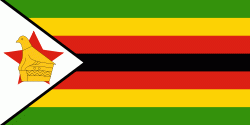Kwekwe, known until 1983 as Que Que, is a city in the Midlands province of central Zimbabwe. The city has a population of 119,863 within the city limits, as of the 2022 census, making it the 7th-largest city in Zimbabwe and the second-most populous city in the Midlands, behind Gweru.
It is located in Kwekwe District, in the Midlands, in the center of the country, roughly equidistant from Harare to the northeast and Bulawayo to the southwest. It has witnessed robust population growth since the 1980s, growing from 47,607 in 1982, 75,425 in 1992 and the preliminary result of the 2002 census suggests a population of 88,000. In 2012, the city's population was estimated at 100,900 people. It is a centre for steel and fertiliser production in the country.
Kwekwe and neighbouring Redcliff are the headquarters of Zimbabwe Iron and Steel Company (ZISCO), the country's largest steelworks. It also hosts the Zimbabwe Iron and Smelting Company (ZIMASCO), the largest ferrochrome producer, and one of the biggest power generating plants, ZPC-Munyati, in Munyati, a suburb of Kwekwe. Kwekwe is Zimbabwe's richest city in terms of minerals.


















